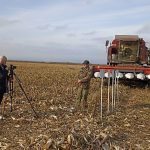Global climate changing technology was developed in KBSU
A group of scientists from KBSU has developed a technology and a device for recording the dynamics of carbon dioxide emission and absorption by agricultural plants in real time.
An application for an invention has been submitted. Research work in this area is carried out at the university as part of the strategic academic leadership program «Priority 2030» in order to implement the KBSU strategic project «Water well-being and green economy».
In particular, scientists have found that on one hectare of an intensive apple orchard that has just entered the fruiting stage, annual shoots are able to deposit more than two tons of CO2, and an increase in microbial biomass in the soil due to the artificial introduction of biological products by more than 14% increases the ability to transform greenhouse carbon dioxide gas into carbon fixed in the soil.
The head of the center for decarbonization of the agro-industrial complex and the regional economy of the KBSU, candidate of agricultural sciences, senior researcher Amiran Zanilov spoke about the significance of the invention, in respect of which a patent application has been filed:
The complex allows you to take into account and simulate CO2 flows in a closed cycle — between soil, plants and atmosphere. The method of direct fixation of CO2 in the atmosphere and the content of CO2-equivalent in plants and soil established the accuracy of the balance calculation at 97.4%.
The structural elements of the device make it possible to optimize the humidity of air and soil — irrigation management and removal of excess moisture; lighting regulation; optimization of the gas composition of air (CO2, O2); airflow simulation.
The applied technique makes it possible to take into account the direction of transformation processes and to model the cycle of carbon dioxide. Most of the existing methods are characterized by a short duration of observations, the results of which are extrapolated to the entire growing season. Our model allows us to avoid errors in the calculations.
The method proposed by KBSU scientists, as well as the tested installation, can be used in studies of CO2 emissions for a wide range of agricultural crops, as well as in assessing the effect of various agrochemicals on the carbon sequestering capacity of plants and soil.
Translated by Gekkieva J.A.




